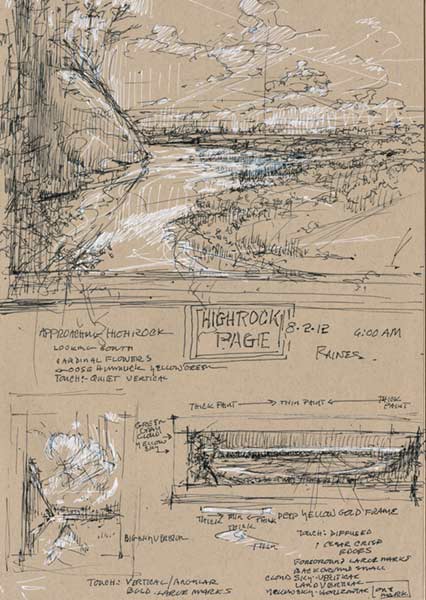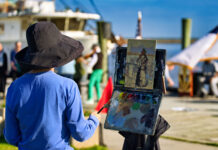Kevin Raines is bullish on land conservation, and he sees artists as key conduits for communicating the beauty and sublime power of nature. He’s pursuing this on an international level.
Lead Image: “Field Study,” by Kevin Raines
In his view, conservation starts when people make a connection with the land. “And the most authentic way is to be there, in it,” says Raines. “That’s the point of contact; it’s the first-person experience, the passing of time in that place. Plein air painters, or anyone who paints or draws or creates from life, experience that intersection of art and direct experience. We don’t copy reality, we express an experience.”


Raines has traveled the world under the auspices of UNESCO depicting key landscapes, he’s worked with the Nature Conservancy, and now he’s hatching another idea in which he will portray the watersheds of three great rivers — the Hudson in North America, a river in Europe, and one in Asia. His work is currently on display (until October 11) at View in Old Forge, New York, in a show titled “Share the Experience: Adventures in the Adirondacks.” More than 80 pieces depict the beauty of the Adirondack Mountains, with an eye toward an appreciation of nature, and, by extension, the conservation of land.

“Artists have been doing this all along,” Raines asserts. “I see the process of art and conservation as very, very similar. The Hudson River School painters were doing this, experiencing nature scientifically and philosophically. It’s metaphysical as well. It’s the identification of what is significant, and sharing that with others. Through the individual nature of each painting, I know that someone out there may connect with one of these pieces and it may inform them through beauty or the sublime, and maybe something will happen. Maybe it will be an aesthetic experience that makes them feel something of value.”

The artist is wrapping up his career as an art teacher at Notre Dame of Maryland University in Baltimore. Although he plans on spending more time in New York, in his upstate home, Raines is itching to travel again, and to paint along the way. His ambition is significant, in more ways than one — he is starting on a plein air piece right now measuring 74” x 50”. He does it for land conservation, and he does it for himself. That’s fitting, because he sees art as having two lives. “Art happens when the individual creates it,” says Raines, “but it is experienced twice. Once, in the act of creation, then in the physical world, a second time, when the viewer sees it. The viewer stops for a minute to look, then thinks about it for a second, or a whole lot.”

Land conservation can be a political issue, and Raines will sigh when this is brought up. “I’m aware of the practice of instant gratification,” he says. “I know there are those who are not concerned about posterity, and I’m not happy about that at all. In my art, there is a cause behind it, but I play that down because there are things that are really fundamental that happen inside a person. If art touches a nerve in someone, well, that nerve was touched in me, and that’s why I painted it.”
Raines says, “Art grows out of the rapture of the experience.”




